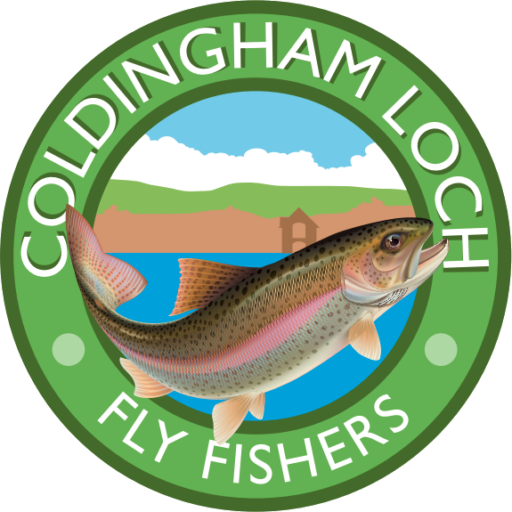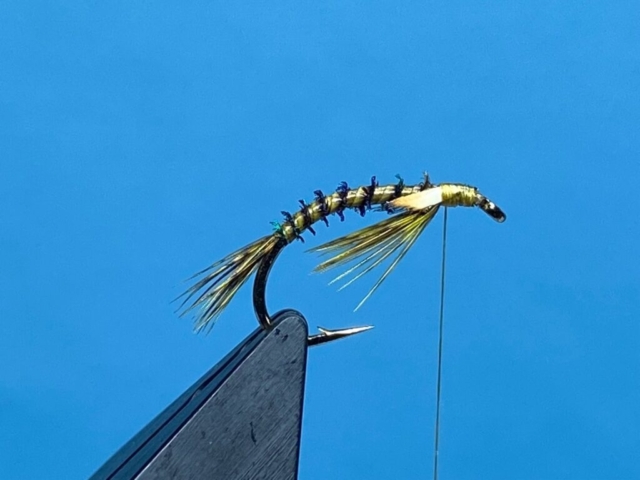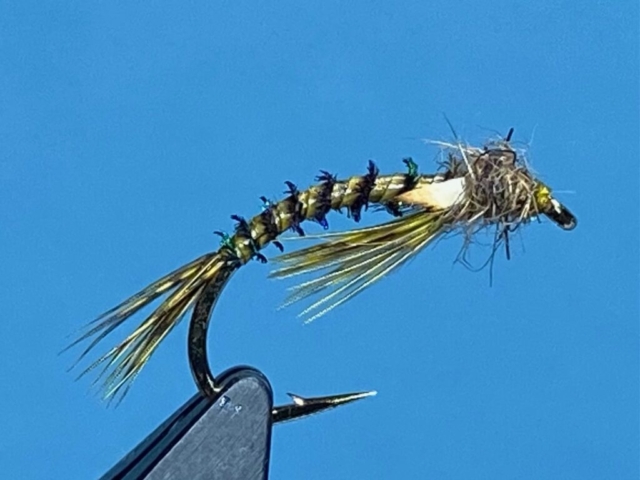A Fly to Tie & Try for May 2023 by Les Lockey
Peacock Eye Quill Diawl Bach
Hook: Kamasan B110, heavy grub hook, size 10 to 14.
Thread: Roman Moser Power Silk, 10/0, in olive, or any flat olive thread.
Tail: Partridge hackle fibres, dyed yellow.
Body: Peacock eye herl quill, dyed fluorescent yellow.
Beard hackle: Partridge hackle fibres, dyed yellow.
Cheeks: Split jungle cock nail.
Head: Fox squirrel fur.
TYING
Photo 1. With the hook secured in the vice, catch on the thread behind the eye and wind on a smooth bed of thread round the bend to just past the barb and remove the waste thread.
Photo 2. Align the tips of a small bunch of partridge hackle fibres, remove them from the feather and tie them in on top of the shank as a tail with two turns of thread, leaving the waste ends the same length as the body. From the eye section of a peacock eye feather, remove one eye herl quill and tie it onto the shank by the thin end and with the dark flue section at the bottom. Bind everything down with touching thread turns stopping about 3mm. from the eye and remove the waste quill tip.
Photo 3. Carefully add a light coating of superglue to the thread underbody, and then wind the quill in almost touching turns up the shank to about 3mm. from the eye. Secure the quill with a few turns of thread, remove the excess herl and allow the glue to dry before continuing.
Photo 4. As for the tail, align the tips of a small bunch of partridge hackle fibres, remove them from the feather and tie them in under the shank as a beard hackle, about the same length as the tail, then carefully cut away the waste ends.
Photo 5. Tie in a split jungle cock eye so it sits equally on either side of the body and remove the waste feather.
Photo 6. Dub a small pinch of fox squirrel fur onto the thread and wind on the dubbing noodle to form a small thorax. Add some varnish to the thread, whip finish through it and remove the thread to complete the fly.
Tying Tips
- A flat tying thread helps to produce a nice smooth underbody on which to wind the peacock eye herl quill.
- Unlike most peacock eye quill patterns, the herl quills used here are not stripped and are used straight from the peacock eye feather, with the best herl quills coming from those quills that pass through the eye of the feather. On these quills, the flue is quite short and aligned along just one edge, which makes them ideal for creating the segmented body. It is worth noting that the longest quills come from the largest eyes, which not only allows easier manipulation, but it also means larger hook sizes can be used.
- Be careful when using superglue. A light coating is all that is needed, and always allow the glue to dry before continuing to complete the fly.
- When winding the quill, instead of using fingers, or hackle pliers, I use a lightweight plastic electrical clip. This allows the quill to be held by the very end which maximises the useful part of the quill, prevents damage to the herl and gives greater feel when winding the quill.
- If jungle cock nail feathers are not available, try using fluorescent yellow or chartreuse goose biots, or for a more natural look similar to that of jungle cock, try caramel coloured biots from Flybox.
- Peacock eye feathers come in a wide range of dyed colours with orange, olive, claret, and black being very useful alternatives.
Fishing hints
- This pattern, tied in a variety of colours and sizes, is an extremely versatile general nymphal representation for a number of insect including midges, olives, caddis and even small damsel nymphs, and as such, it can be fished throughout the season on any density line, although I mostly use a floater or a slow intermediate.
- Try to match the retrieve to the nymph being imitated. For midges and olives, a static or very slow retrieve is usually best. A jerky figure of eight retrieve with numerous pauses works well when targeting damsel nymph feeders, while a sink and draw retrieve using long slow pulls with long pauses is the best option when the fish are feeding on caddis pupae. The pattern also works well when fished as part of a team of nymphs with a slow figure of eight retrieve, which is probably best achieved using the washing line technique.









Recent Comments